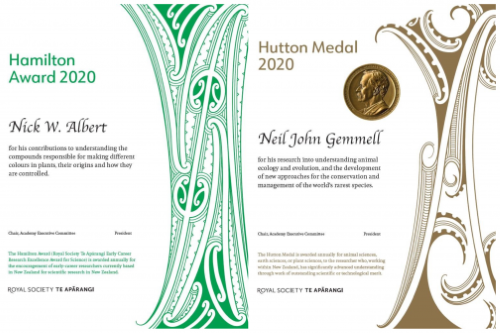New design of medal and award certificates

In 2020, the Society’s medal and award certificates were refreshed with the incorporation of designs by Vianney Parata (Te Ātiawa Ki Whakarongotai, Ngāti Toa, Ngā Puhi, Ngāti Porou, Ngāti Kahungunu ngā iwi) and Fortyfive Design. Vianney details his inspiration behind the new designs below.
Separate designs have been created for the Society’s medal winners and the Early Career Research winners.
Early Career Researchers awards
Download details of the new designs.
Pūhoro

Pūhoro was inspired by water and the way a Waka broke the current to move forward, traditionally used on the takere (hull) of Waka signifying speed, swiftness and movement. In this piece I have used pūhoro to represent the journey through research and the many ways they have had to break the water to move forward with a sense of achievement.
Mangopare

Mangopare is a common design in varying kōwhaiwhai patterns and represents the hammerhead shark. It is used to represent strength, determination and purpose among many other things. In this design they represent the researchers determination and excellence they have strived for and realised in their various disciplines.
Pītau/Koru

Pītau in the context of kōwhaiwhai represents the young fern frond. It is used repeatedly throughout most kōwhaiwhai designs and can represent new growth and development. This reminds us of the voyage of our tīpuna from Hawaiki to Aotearoa and the way our tīpuna had to adapt and grow in their new environment, a representation of new life. In this piece I have used pītau to represent growth and development the researcher has had and also has been part of.
Niho Taniwha

Niho Taniwha design represents the tooth of the Taniwha. There are a few trains of thought on this design, one being that it represents humankinds’ connection to the spiritual world and our Atua. The other is that it is a cautionary tohu, reminding us of the dangers of the natural world and the Taniwha that protect those spaces. The reason I have used this design is to offer protection for the researcher in all their endeavours to come, to acknowledge the work they have done and that they are now a kaitiaki protector of the knowledge they have.
Haehae

Haehae (long parallel lines) are said to represent whakapapa, past, present and future. In this design I have used it to represent the knowledge in which the researcher has gained throughout their career, the start of their journey in the research fields and how much they have grown and how much knowledge and wisdom they hold and also a reminder that there is still more to learn from.
Research Honours awards
Download details of the new designs.
Pūhoro

Pūhoro was inspired by water and the way a Waka broke the current to move forward, traditionally used on the takere (hull) of Waka signifying speed, swiftness and movement. In this piece I have used pūhoro to represent the journey through research and the many ways they have had to break the water to move forward with a sense of achievement.
Rua Kūmara

The Rua Kūmara design represents the Kūmara pit of traditional times. The white spaces are said to represent the pit and the pītau the fronds of the kūmara. The kūmara was particularly important in Māori society for a number of reasons. It was a staple food source of our tīpuna and was used for ritual purposes also, for instance, to lift the tapu of a newly constructed whare, a cooked Kūmara was thrown over the whare, and/or buried someplace near the whare. Another reason however that kūmara has such a strong presence in our creation traditions and is often depicted in Māori society is the fact that kūmara were one of the only foods that were brought to Aotearoa by our tīpuna and survived here due to the difference in climate/soil and flora environment. The kūmara therefore marks a feat for our tīpuna in terms of their agricultural skill/knowledge. The pattern also represents wisdom handed down from generation to generation.
In this design I wanted to acknowledge the level of skill and knowledge one must have in order to receive such a tohu of excellence and also highlight a particular whakataukī ‘Kāore Te kūmara e kōrero mō tōna ake reka’;’The kūmara doesn’t speak of its own sweetness’ we show it by doing the work, this represents the persons research, work ethic and mana motuhake.
Pākati Haehae

Pākati (small lines) Haehae (long parallel lines) are said to represent whakapapa, past, present and future. In this design I have used it to represent the knowledge in which the researcher has gained throughout their career, the start of their journey in the research fields and how much they have grown and how much knowledge and wisdom they hold and also a reminder that there is still more to learn from.
